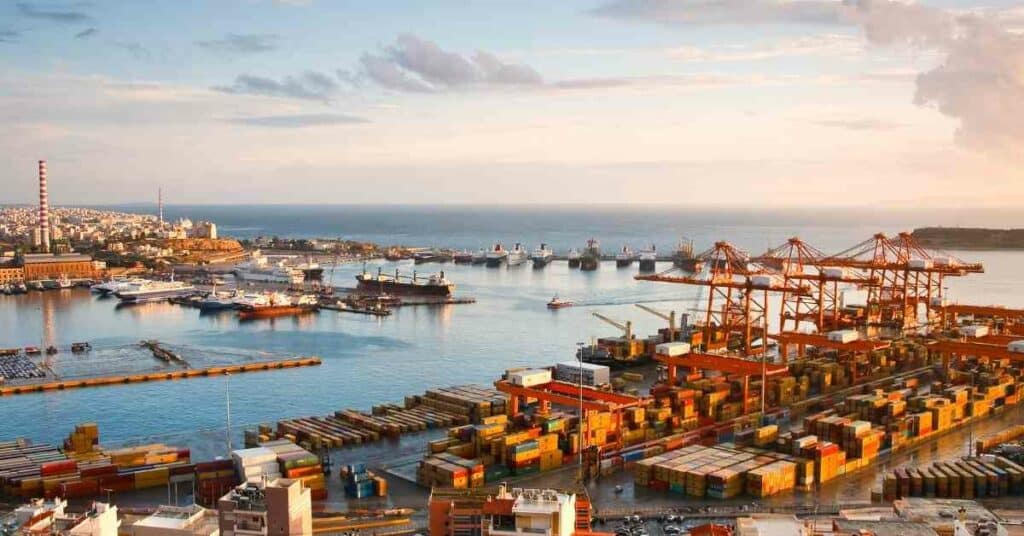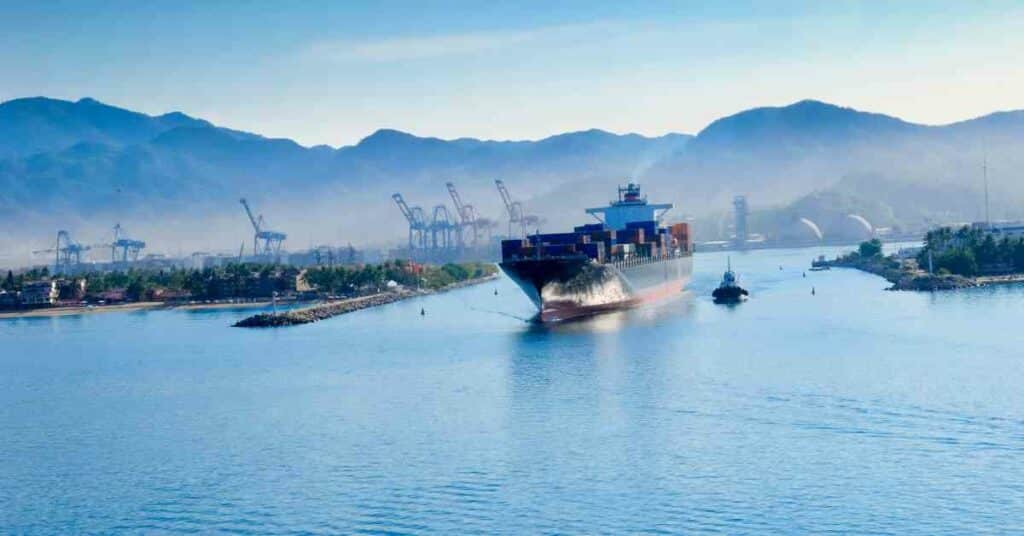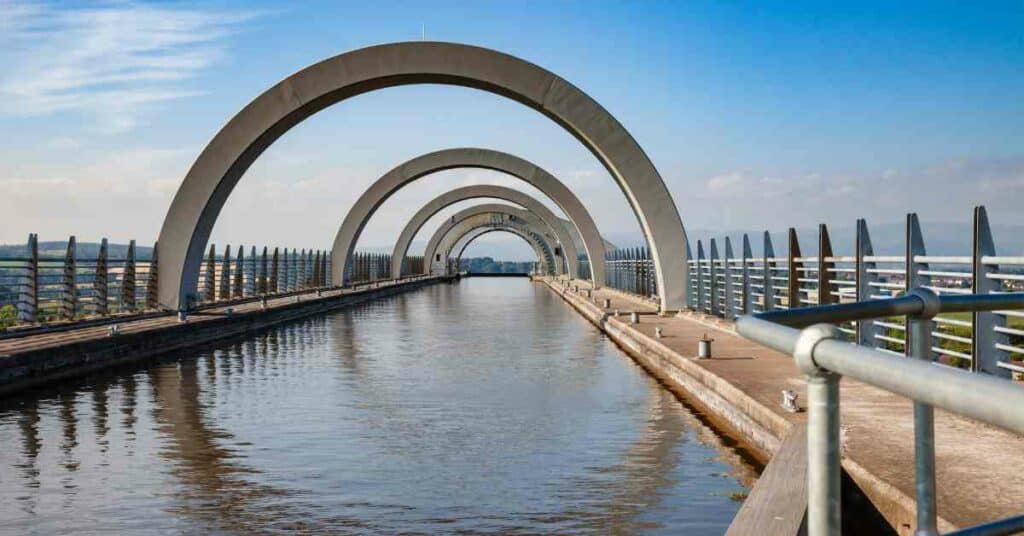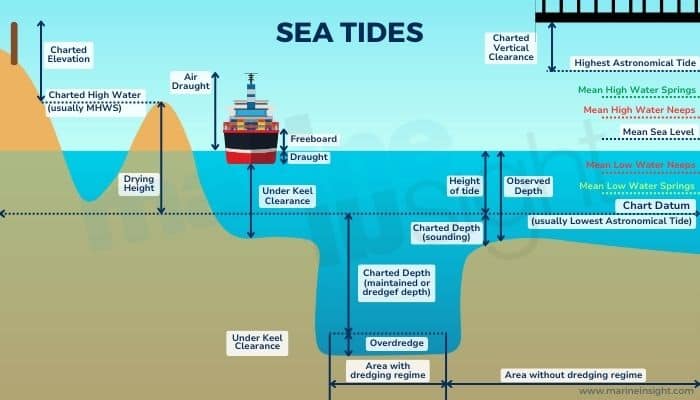6 Major Ports in Argentina
Table of Contents
Argentina is a developing country in the South American continent and the 8th biggest nation in the world in terms of land area.
Having substantial natural resources, an educated populace, an export-oriented agricultural sector and a diverse industrial sector, Argentina’s economy has been witnessing considerable progress in the last three decades.
Due to its strategic location amidst the South Atlantic Ocean on its western borders, the country has more than 70 ports and harbours that handle the majority of its international maritime trade with Brazil, China, the United States, Chile, Vietnam, Germany and Paraguay.
Let’s take a look at some of the major ports in Argentina
Port of Buenos Aires
The Buenos Aires port is the major seaport of Argentina, situated on the southern bank of the River Plate. It is also the country’s commercial, industrial and cultural centre with maritime connections to Paraguay, Uruguay and Brazil through an intricate river network. A transhipment hub of South America, it is also the thirteenth biggest economy in the world sustained by the port city’s strong services, advertisement, financial and real estate sectors.
The city has numerous industries like leather, grain, tobacco, agricultural products, meat, dairy processing, automobile assembling, clothing, chemical plants and so on. The Pampa Humeda which lies a few kilometres from the port is the biggest agricultural region of the country. Hence, the port handles diverse cargoes while being a popular tourist destination. Around 2300 ships, 11,810,000 tonnes of cargo, 1,152,000 TEU, and 1,000,000 passengers are handled at Buenos Aires annually.
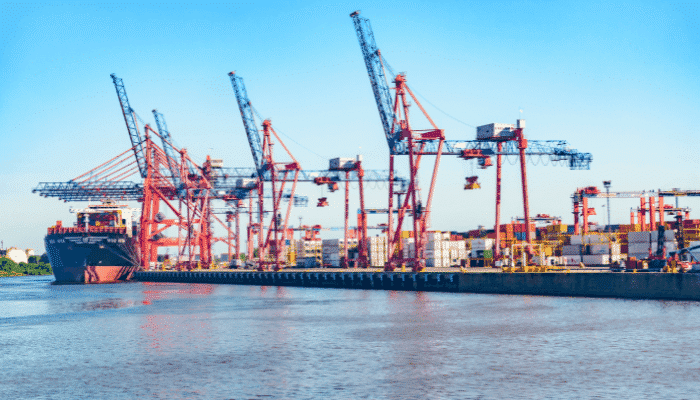
The port stretches over 45 hectares and incorporates two cargo handling areas namely the New Port or the Puerto Nuevo which can be accessed through the northern channel and the Southern Port also known as Puerto Sur. Another part of the port called Darsena Norte lying in the Northern basin is utilised for berthing the country’s naval ships and licenced cruise liners including ferries.
Container Terminal
The port’s container handling facility became operational in 1994, built over 25 hectares and comprising 4 container berths with a total quay length of 890 m and 12 hectares of container storage yards. A logistics hub is also constructed in the port premises for efficient container handling along with a Container freight station decked with state-of-the-art scanning systems reducing the processing time manifold. The terminal has a stacking area spanning 16 hectares and also 490 reefer connections.
Decked with the latest equipment like the six rail-mounted post-Panamax gantry cranes, mobile cranes, seven 50 ton reach stackers, various forklifts, tractors and trailers, the port provides quick services to its worldwide customers.
It also has two breakbulk terminals, one operated by APM Terminals and the other by Maersk covering 9 hectares for dealing with shipments of construction material, project cargoes, grains and agricultural goods.
Cruise terminal
The port’s passenger terminal opened in 2011 and is renowned as South America’s largest cruise facility. Offering the tourists a luxurious experience, this modern terminal serves over 600,000 passengers annually. The two 350 m long wharves can accommodate two cruises at once.
Port of Dock Sud
Lying on the shores of the river Rio de la Plata, Dock Sud is a subsidiary facility of Buenos Aires just 50 kilometres from the New Port. It was constructed for diverting the increasing cargo traffic at Buenos Aires port and to solve the problem of port congestion. Dock Sud has several terminals for handling LPG, chemicals, containers and general cargo.
Its navigation channel covers 60 m and its water depth is 8.5 m. The port’s Eastern basin comprises 5 berths with 1355 m of wharfage for handling fishing ships, small boats and cargo carriers. It also has a drydock offering ship repair and maintenance services. The Southern Basin offers ferry services to the cities of Montevideo and Colonia in Uruguay through its passenger terminal.
The Port also has a Gas terminal which includes a finger pier spanning 290 m, allowing gas carriers to enter the 640 m loading dock through the southern entrance channel capable of accommodating ships weighing more than 50,000 DWT with an LOA of 230 m. The oil handling facility deals with petroleum, oil, fuels and has an entrance channel of 100 m leading to the four oil jetties with mooring dolphins, capable of handling oil tankers weighing up to 100,000 DWT.
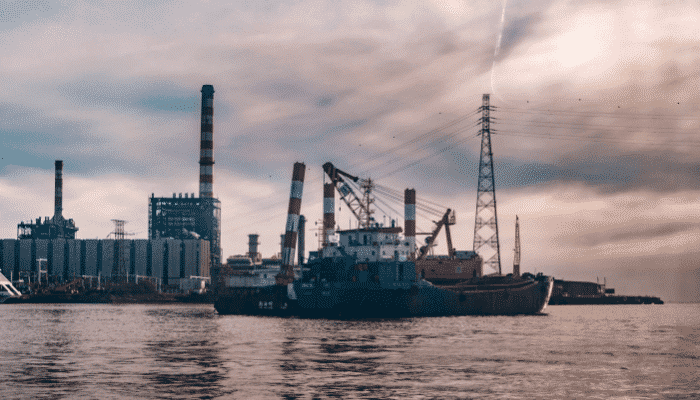
The Container terminal lies on the western side and is owned by a private shipping company. Covering 26 hectares, the terminal is directly linked with rail services. It has 5 berths with a total length of 630 m however it is currently undergoing expansion. The terminal’s freight station and warehouses span 13,00 sq m with covered storage space for accommodating 8,000 TEUs and a 6-hectare area for stacking empty containers. Lastly, the terminal has 310 reefer connections.
The General Cargo handling facility is adjacent to the container terminal and is the oldest area of the port comprising 5 berths for dealing with shipments of fruits, vegetables and bulk cargoes.
Ports of Bahia Blanca

Bahia Blanca Bay has several port facilities spanning over 30 kilometres however the most significant are Port Galvan, Port Rosales and Ingeniero White harbour. The Bahia Blanca main port area is accessible through a 96 km long and 185 m wide entrance channel that accommodates vessels up to a draught of 13.5 m. Oriented towards handling shipments of dry cargo and liquid bulk, approximately 112,677,300 tonnes of cargo and more than 1000 ships pass through Bahia Blanca Bay annually.
The western entrance channel from the Atlantic ocean leads to the Punta Ancla and Ciguena buoys that deal with hydrocarbon shipments through their 2 SBMs that are utilised by oil tankers for discharging crude oil to the refinery at La Plata.
Ingeniero White Harbour
This harbour is the key export outlet for agricultural goods especially grains grown in the southern part of the country near Buenos Aires and La Pampa. It is also utilised for shipping fresh fruits from the Rio Negro region. The port also handles shipments of frozen fish and is divided into two areas for handling different merchandise.
The port area designated for handling cereals and grains comprises the grain terminal operated by a consortium of three private firms. The western port area deals with frozen cargo and has cold storage facilities covering 20,000 m2 located near the berthing area allowing efficient cargo handling and storage. Adjacent to the western area is the logistics centre which was constructed in 2005 and a multifunctional wharf for handling excess containerised goods and conventional cargo thereby reducing congestion.
Port of Galvan
Galvan port was built as a cereal handling facility for the Pacific railways however it diversified its operations. It has numerous wharves for dealing with general cargo and two berths leased to Energen SA for accommodating shipments of gas and liquid fuels along with chemicals. Spanning 17 hectares, with a storage capacity of 80,000 tonnes it is a crucial port of Bahia Blanca, well-linked with railways.
Port Rosales
The port has a floating dock covering 310 m with a depth of 25 m. The port accommodates tourist boats, cruises and yachts while functioning as a workshop offering maintenance and repair services for the deepsea boats, ships, trawlers and naval vessels. After entering the port harbour, there are 2 monobuoys for berthing of oil tankers followed by a 107 m long wharf for accommodating only fishing vessels.
Puerto Belgrano
The port of Belgrano serves as the primary naval base of Argentina located at the mouth of Bahia Blanca Bay, incorporating two big drydocks and repair workshops serving commercial ships and the country’s naval fleet.
Port of La Plata
The port of La Plata is located just 54 kilometres from Buenos Aires on the Rio de la Plata river with facilities situated in Ensenada. The port’s entrance channel has a turning basin with a diameter of 250 m and is linked with all major Argentine ports through the National rail and highway networks. It handles roughly 3,000,000 tonnes of cargo and more than 700 ships every year.
It has two main cargo areas namely the Gran Dock and the Port of Ingeniero Rocca.
The former is used by oil tankers coming from the country’s national oil fields and handles crude oil, petroleum and its derivatives and liquid gas. A petrochemical plant loading benzene and other chemicals is also located on the Gran Dock whose three berths are used for exporting raw coke and calcinate while an additional berth handles general cargo. On the eastern side is the Dock’s passenger terminal with 2 berths for handling tourist ships and small ferries.

Ingeniero Rocca houses the rolling steel mill where steel is transformed into rolled sheets and wires for export on its 155 m long wharf that can accommodate Panamax size ships.
The port’s Rio Santiago facilities comprise the Astilleros Shipyard offering shipbuilding and repair services for vessels. It has a floating dry dock and a free zone covering 225 hectares that works as a CFS for containers unloaded at the Buenos Aires port.
Port of Quequen
Quequen port is situated on Argentina’s northeastern Atlantic coastline and is a chief grain port of the country. Deriving its name from the native inhabitants of the region, the port has extensive facilities for handling exports of grains, conventional cargo, frozen seafood and petroleum goods. Capable of accommodating ships with an LOA of 230 m and a maximum draught of 12.3 m, the port deals with 4500,000 tonnes of cargo and more than 450 ships every year.
Quequen is protected by two breakwaters that are 210 m wide and 11 m deep. It comprises six wharves out of which one measures 200 m and has 2 jetties connected with pipelines leading to oil storage tanks. It is also used for handling agricultural goods.
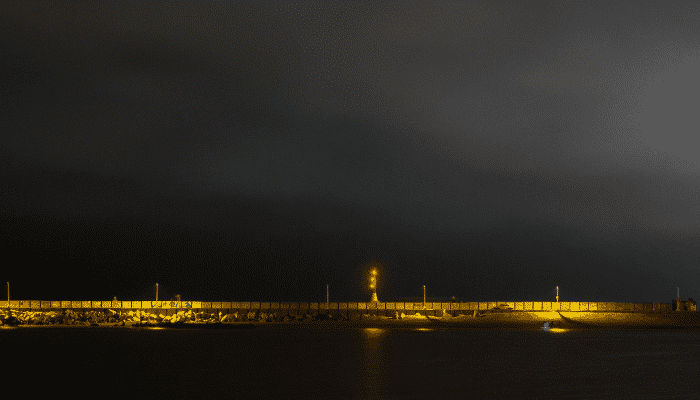
Two berths comprise the Quequen Grain terminal. Spanning 270 m and equipped with three dolphins, it has a storage capacity of 115,000 tonnes of grains in its 5 silos and numerous warehouses.
The Necochea part of the port also incorporates six berthing facilities mainly used by fishing vessels. Three berths are dedicated to general cargo and bulk cargo with a capacity of storing 50,000 sq m of fertilisers. Another berth is used for discharging fuel and has two dolphins measuring 185 m.
Port of Santa Fe
Santa Fe port lies just 90 nautical miles from Rosario, at the confluence of rivers Salado and Parana and is the world’s most inland port facility handling maritime trade of Argentina and the nearby landlocked nations of Bolivia and Paraguay.
A multipurpose port, it is crucial for the economy of Santa Fe province as it serves the agricultural producers by exporting their produce like wheat, soybean, corn, peanuts, meat along with minerals such as copper, gold and automotive parts. It receives bulk shipments of sugar, petroleum products and construction material. Approximately 52,000 tonnes of grain is exported from the port on cargo ships and 20,000 tonnes on barges annually.
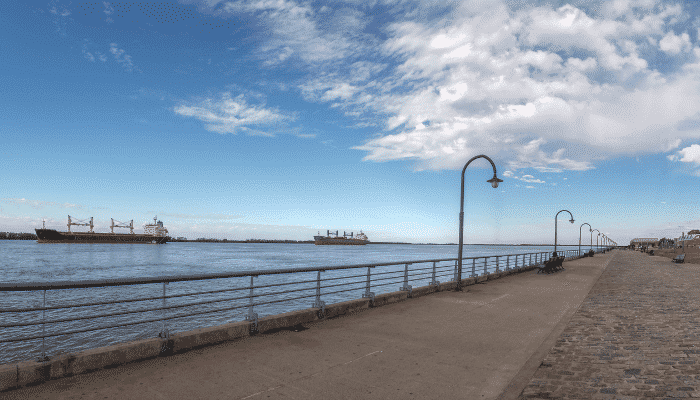
Covering 70 hectares, the port can accommodate ships with an LOA of 220 m and a beam of 30 m. Santa Fe consists of two docks, the first used for handling grains, vegetable oils and bagged cargoes while the second dock does not receive any cargoes. The coastal dock deals with conventional cargo and a derivation channel handle flammables and hazardous substances.
It serves a diverse region, not only by acting as a vital cargo port but by also providing recreational services to the tourists. The port has a passenger berth welcoming cruises and small boats. The climate along with the scenic beauty makes Santa Fe a dream vacation destination. Operational throughout the year, the port is equipped with the latest operating systems while providing financial services to its worldwide customers. The Port’s container terminal handles all the containerised cargo and contains one of the biggest cranes with a lifting capacity of 250 tonnes.
You might also like to read:
- 10 Major Ports In Brazil
- 5 Major Ports in Portugal
- 5 Major Ports in Peru
- 7 Major Ports of the United States
- 5 Major Ports In Guatemala
Disclaimer: The authors’ views expressed in this article do not necessarily reflect the views of Marine Insight. Data and charts, if used, in the article have been sourced from available information and have not been authenticated by any statutory authority. The author and Marine Insight do not claim it to be accurate nor accept any responsibility for the same. The views constitute only the opinions and do not constitute any guidelines or recommendations on any course of action to be followed by the reader.
Do you have info to share with us ? Suggest a correction
Latest Maritime Knowledge You Would Like:
Get the Latest Maritime News Delivered to Your Inbox!
Our free, fast, and fun newsletter on the global maritime industry, delivered everyday.

